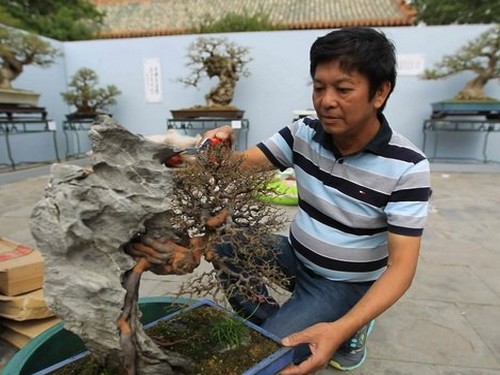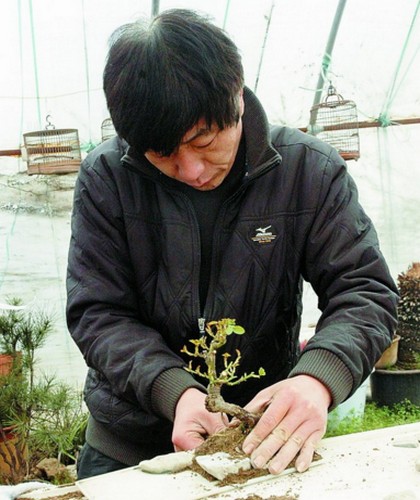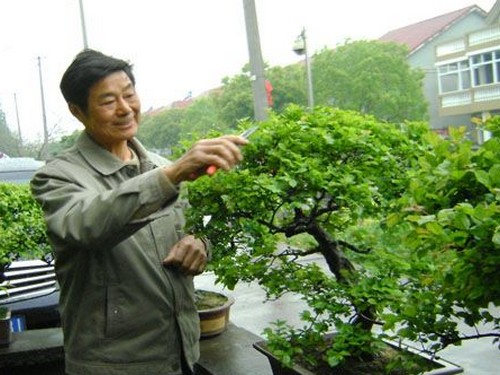Bonsai creation: the first intention, throughout
The so-called "intention" is that before the creation, after the author gets the tree embryo, or the processing method of the rock, according to its morphological characteristics and the characteristics of the material itself, combined with its own artistic accomplishment, make a general conception of the work. This thinking process includes the use of the appearance, size and branches of the works and the design of the matching pots, as well as the basis for future creation. Therefore, the intention is to focus on dealing with the "spirit" of the work, while the composition focuses on dealing with the "shape" of the work. The two are dialectical unity, which are both different and closely linked. Therefore, while carrying out the conceptual composition, we should properly deal with the relationship between the two in order to get the works with new idea, beautiful composition and unique charm.

Intended to express what theme, this is the most important, the theme, both artistic conception, that is, poetic feelings. The artistic conception of the theme is the first criterion for evaluating bonsai works. The intention is to be elegant and novel, and the works should have dynamic charm, oppose mediocrity, "the scene is free from danger", stereotyped and stereotyped, and do not blindly copy nature. It is necessary to correctly handle the relationship between strange and real. Strange is also real, it is only from nature, real life to extract unexpected, fascinating, lively and interesting and reasonable things.
The second is material selection. As far as the pile scene is concerned, we should not only consider the characteristics of tree species, but also pay attention to the appearance and posture of the individual. The selection of tree species requires the characteristics of strange tree stalk, easy root exposure, trunk resistance, resistance to cutting, dense branches and leaves, beautiful flowers and fruits, strong adaptability, resistance to barren, resistance to transplanting, easy to pot, etc., but the requirements are different with different themes. If you use something like rattan to show the magnificence of Cangu, and a graceful charm like pines and cypresses. It will get half the result with twice the effort, and even in vain. At the same time, the inner water bonsai material selection, should also grasp the stone texture, color, shape, texture and other characteristics, material modeling, or material selection. For example, it is just right to use sharp sand and stone, axe to split stone to pull out Qifeng, and to make tiger cave dragon pool with hollowed-in stalactite and cliff magma stone. To be familiar with the stone shape of "leakage, penetration, thin, wrinkle" characteristics. Thin is tall and straight and magnificent; wrinkle is rich in hierarchical changes; leakage, penetration is unfathomable, avoid congestion, each has its own wonderful use.
Third, in what form. Whether to make landscape bonsai or pile scenery. If you want to make a mountain waterscape, you have to first choose whether it is a water basin, a dry basin, or a flood and drought basin; if you decide the pile scene, it is a natural style that is bold and sprinkled at will, or is it carefully carved, just like the regular style of meticulous painting; whether it is cut, flat, or another primary and secondary, both.
Fourth, the primary and secondary arrangement, far and near position of everything in the basin should be considered around the theme, and the artistic means of preparation should be applied to serve the creation of artistic conception. If you do not get the right meaning and aimlessly before you start the creation, you will not be able to create good works if you do not take care of each other in the basin. An excellent work must have a new idea and elegant style. Bonsai artists in our country pay great attention to the creation of artistic conception, and each new work is unique, which is a fine tradition and should be well inherited and carried forward. Fan Shihu of the Song Dynasty said in the preface to the poem "Xiao Emei": "near the Lingbi ancient stone, it is absolutely similar to the peak of Da'e Zhengfeng, the day of its name." Little Emei. Dongpo is often named Lushan Mountain, which may not be as lifelike as this stone. Make Xiao'e Mei Song to praise it. The poem also says, "San'e stands high across the cliff and leans half way to the sky." Dragon pedals and tigers lie down and lie down, leering at the foam Tuojiang River. Yu was famous for his reputation as a hero from Minyang under him. In the face of the ancient stone of Lingbi, the poet is rich in the true meaning of Mount Emei, and thus thinks of the great deeds of ancient Yu in controlling water for the people and turning harm into benefit, which makes the work full of poetic and picturesque flavor.
Before making bonsai, we first have ideas, and after the overall situation is decided, in the actual creative process, we have to repeatedly examine the materials, but modify and add. It is called "pen to meaning" in traditional Chinese painting. This is the continuation of the intention, which has become far more important in bonsai creation than in traditional Chinese painting. Because bonsai materials can not be like pen and ink, can be sprinkled by the painter at will, but must take care of the natural beauty of the materials. Therefore, carry out the idea in the bonsai creation all the time, can make it reach the perfect condition.
Time: 2019-05-23 Click:
- Prev

Bonsai creation: deficiency and reality are born together, and they are dense and sparse.
The so-called deficiency and reality refers to the relationship between fullness and emptiness, sparseness and density. When it is too full, it looks clumsy, bloated, and suffocating. Therefore, it is necessary to be sparse and dense, and it is suitable for deficiency and reality. If it is dense in one place, it must be sparse in one place in order to soothe its qi. But should not be too thin, lest all things in the basin lose contact, and the Lord does not care for each other.
- Next

Bonsai creation: strange layout, the small sees the big
After the abdominal manuscript is typed, it can be arranged according to the rules. Layout is the layout and settlement of the scenery, that is, modeling. No matter what the theme is, bonsai emphasizes the artistic effect of seeing the big in the small more than the garden. The better the effect, the higher the artistic value of bonsai. Although there are large bonsai in bonsai
Related
- Fuxing push coffee new agricultural production and marketing class: lack of small-scale processing plants
- Jujube rice field leisure farm deep ploughing Yilan for five years to create a space for organic food and play
- Nongyu Farm-A trial of organic papaya for brave women with advanced technology
- Four points for attention in the prevention and control of diseases and insect pests of edible fungi
- How to add nutrient solution to Edible Fungi
- Is there any good way to control edible fungus mites?
- Open Inoculation Technology of Edible Fungi
- Is there any clever way to use fertilizer for edible fungus in winter?
- What agents are used to kill the pathogens of edible fungi in the mushroom shed?
- Rapid drying of Edible Fungi

